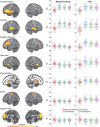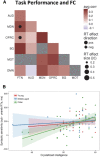Robust Resilience of the Frontotemporal Syntax System to Aging
- PMID: 27170120
- PMCID: PMC4863058
- DOI: 10.1523/JNEUROSCI.4561-15.2016
Robust Resilience of the Frontotemporal Syntax System to Aging
Abstract
Brain function is thought to become less specialized with age. However, this view is largely based on findings of increased activation during tasks that fail to separate task-related processes (e.g., attention, decision making) from the cognitive process under examination. Here we take a systems-level approach to separate processes specific to language comprehension from those related to general task demands and to examine age differences in functional connectivity both within and between those systems. A large population-based sample (N = 111; 22-87 years) from the Cambridge Centre for Aging and Neuroscience (Cam-CAN) was scanned using functional MRI during two versions of an experiment: a natural listening version in which participants simply listened to spoken sentences and an explicit task version in which they rated the acceptability of the same sentences. Independent components analysis across the combined data from both versions showed that although task-free language comprehension activates only the auditory and frontotemporal (FTN) syntax networks, performing a simple task with the same sentences recruits several additional networks. Remarkably, functionality of the critical FTN is maintained across age groups, showing no difference in within-network connectivity or responsivity to syntactic processing demands despite gray matter loss and reduced connectivity to task-related networks. We found no evidence for reduced specialization or compensation with age. Overt task performance was maintained across the lifespan and performance in older, but not younger, adults related to crystallized knowledge, suggesting that decreased between-network connectivity may be compensated for by older adults' richer knowledge base.
Significance statement: Understanding spoken language requires the rapid integration of information at many different levels of analysis. Given the complexity and speed of this process, it is remarkably well preserved with age. Although previous work claims that this preserved functionality is due to compensatory activation of regions outside the frontotemporal language network, we use a novel systems-level approach to show that these "compensatory" activations simply reflect age differences in response to experimental task demands. Natural, task-free language comprehension solely recruits auditory and frontotemporal networks, the latter of which is similarly responsive to language-processing demands across the lifespan. These findings challenge the conventional approach to neurocognitive aging by showing that the neural underpinnings of a given cognitive function depend on how you test it.
Keywords: ICA; aging; functional connectivity; language comprehension; syntax; task demands.
Copyright © 2016 the authors 0270-6474/16/365214-14$15.00/0.
Figures





References
-
- Allen EA, Erhardt EB, Damaraju E, Gruner W, Segall JM, Silva RF, Havlicek M, Rachakonda S, Fries J, Kalyanam R, Michael AM, Caprihan A, Turner JA, Eichele T, Adelsheim S, Bryan AD, Bustillo J, Clark VP, Feldstein Ewing SW, Filbey F, et al. A baseline for the multivariate comparison of resting-state networks. Front Syst Neurosci. 2011;5:2. - PMC - PubMed
Publication types
MeSH terms
Grants and funding
LinkOut - more resources
Full Text Sources
Other Literature Sources
Medical
Miscellaneous
